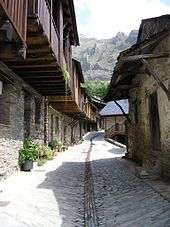Bien de Interés Cultural

A Bien de Interés Cultural is a category of the heritage register in Spain.[1] The term is also used in Venezuela,[2] and other Spanish speaking countries.
The term literally means a "Good of Cultural Interest" (a "good" in the economic sense), although a better translation could be "Heritage of Cultural Interest", as Spain protects not only material heritage, like monuments or movable works of art, but also intangible cultural heritage,[3] such as the Silbo Gomero language.[4]
Some Bienes enjoy international protection as World Heritage Sites or Masterpieces of the Oral and Intangible Heritage of Humanity.
History
In Spain the category of Bien de Interés Cultural dates from 1985 when it replaced the former heritage category of Monumento nacional (national monument) in order to extend protection to a wider range of cultural property. Monumentos are now identified as one of the sub-categories of Bien de Interés Cultural.
Sub-categories
The movable heritage designated as Bienes de Interes Cultural includes archeological artefacts, archives and large works of art. Such protected objects may well be kept in a building which is itself a BIC.[5]
- Non-movable heritage is divided into the following classifications:
- Monumento (monument)
- Conjunto histórico (historical group or set)
- Jardín histórico (historical garden, e.g. the Real Jardín Botánico de Madrid)
- Sitio histórico (literally a historic site, the term is used for cultural landscapes, e.g. Riotinto mines)
- Zona arqueológica (archaeological zone, e.g. Archaeological Site of Atapuerca)
Regional variants

Under the Spanish system regions maintain their own registers of cultural heritage (see Patrimonio histórico español). There have been some differences in approach between autonomous communities. An example is bullfighting (which at a national level is now regulated by the Ministry of Culture).[7] Madrid's regional government considers that bullfighting events should be protected as cultural heritage,[8] whereas in Catalonia a ban on bullfighting came into effect in 2012, although this was later overturned by the Supreme Court.
See also
References
- ↑ (Spanish) Definición de bienes culturales protegidos, Ministry of Culture (Spain).
- ↑ TeleSur.
- ↑ "¿Qué es un bien de interés cultural (BIC)?". 16 January 2013. Retrieved 5 March 2013.
- ↑ Whistled language of the island of La Gomera, UNESCO
- ↑ "Pero… ¿qué es un BIC?". 28 December 2009. Retrieved 13 March 2013.
- ↑ ACUERDO 51/2008 "por el que se declara Peñalba de Santiago, municipio de Ponferrada (León), Bien de Interés Cultural con la Categoría de Conjunto Etnológico". Boletin oficial de Castilla y Leon. 18 June 2008.
- ↑ Antonio Lorca (1 August 2011), Culture Ministry takes charge of the bulls, El País (English edition)
- ↑ (2011), La Fiesta ya es Bien de Interés Cultural, El Mundo (elmundo.es)
External links
- Declaran Bien de Interés Cultural de la República Bolivariana de Venezuela la canción Alma Llanera
- The Protection of Historic Properties: A Comparative Study of Administrative ...By Consuelo Olimpia Sanz Salla
- Procedimiento y proceso administrativo práctico, Volume 2
- XX Jornadas del Patrimmonio Cultural de la Región de MurciaBy Pedro Collado y José Antonio Melgares (coord.)
- Boletin de la Real Academia de la Historia. TOMO CCII. NUMERO III. AÑO 2005By Vv.aa
- Cuerpo Tecnico de la Comunidad Autonoma de Extremadura. Especialidad ..
- Código de la Administración Gallega By Jaime Rodriguez-Arana Muñoz, Miguel Ángel Sendín García
- Manual de arte rupestre de CundinamarcaBy Alvaro Botiva Contreras
- XXII Jornadas de Patrimonio Cultural de la Región de MurciaBy Varios Autores
- Los tesoros del mar y su régimen jurídicoBy Jesús Ignacio Fernández Domingo
- Código legislativo de CantabriaBy Cantabria